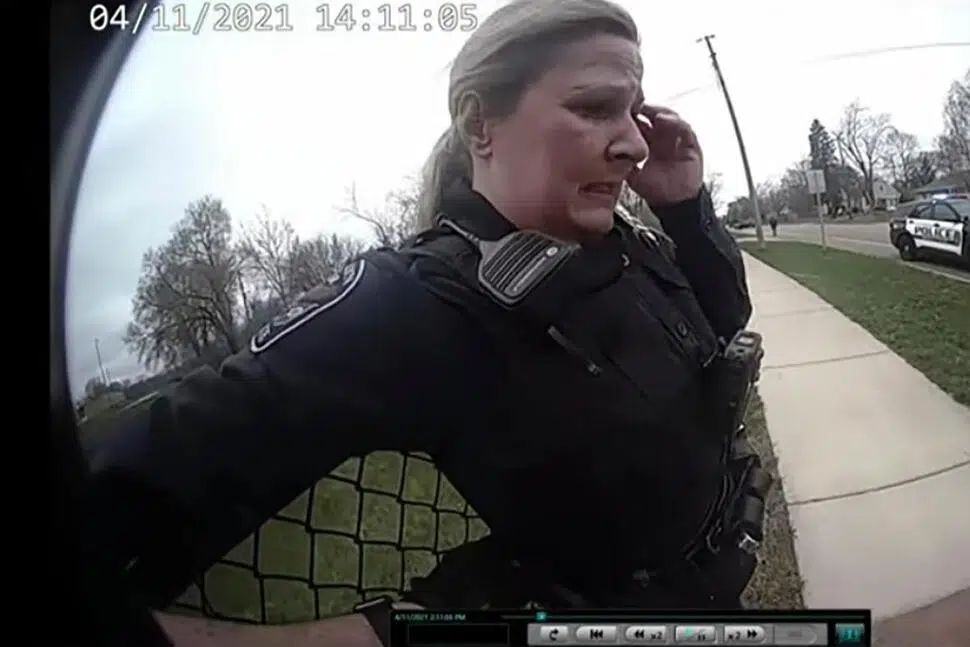MINNEAPOLIS – A police sergeant who was at the scene when Daunte Wright was shot testified Friday that he was holding Wright’s right arm with both hands to prevent the 20-year-old from driving away when he heard Officer Kim Potter yell “Taser, Taser, Taser!” followed by a pop.
Prosecutors say Potter was a veteran Brooklyn Center officer who violated her training. Defense attorneys say Potter made a mistake but would have been justified in shooting Wright if she had consciously chosen to because other officers, including Johnson, might have been dragged if Wright drove away.
Video played in court Friday shows Johnson trying to comfort Potter as she cries and rocks back and forth on the ground with her head in her hands.
Potter, 49, is charged with first- and second-degree manslaughter in the April 11 shooting of Wright, who was pulled over for having expired license plate tags and an air freshener hanging from his rearview mirror.
Potter is white. Wright, 20, was Black. The shooting set off days of protests and clashes with law enforcement in Brooklyn Center just as former Minneapolis police officer Derek Chauvin was standing trial nearby in George Floyd’s death.
Johnson, now a major in the Goodhue County Sheriff’s Office, testified that he opened Wright’s passenger-side door after Wright started to pull away from another officer, and that he leaned into the car, pushed the shift knob forward to make sure it was in park and reached for the keys to try to turn off the vehicle.
Body camera footage shows that as Potter yells “Taser, Taser, Taser!,” Johnson is using both of his hands to hold Wright’s hand and arm.
Jurors also saw the most extensive video yet of Potter’s reaction right after the shooting, with Johnson’s body camera recording her walking to a fence with her hands to her face, saying, “I don’t know what happened.” Johnson takes her gun, for evidence, and puts his own in her holster. Later, after another officer expresses fear she might harm herself, Johnson retrieves his gun, empties it of bullets out of Potter’s view, and gives it back to her.
As portions of Johnson’s body camera video were shown in court, Potter put her head in her hands at the defense table, shook slightly and cried. Wright’s mother, Katie Bryant, also cried quietly.
Under questioning by defense attorney Earl Gray, Johnson said officers were acting properly by trying to arrest Wright after they discovered there was a warrant for his arrest on a gross misdemeanor weapons possession charge and to ensure that the woman in the car — Wright’s girlfriend — was a different woman who had a restraining order against Wright.
Johnson also agreed with Gray that Potter had a right to use force because he might have been injured or killed if Wright had driven away.
Upon further questioning, prosecutor Matthew Frank noted that Johnson didn’t draw his gun or Taser and that he stood up as the car drove away instead of being dragged. Frank also noted that the car didn’t move until after Potter shot Wright.
After Gray had earlier gotten Johnson to acknowledge that Potter had been marked as “exceeds expectations” in evaluations, Frank struck back by asking Johnson: “Does it exceed expectations to draw a gun and shoot somebody to death instead of their Taser?” The judge sustained an objection to the question.
Body-camera video showed Wright pulling away from officers and getting back in his car as they tried to arrest him on the outstanding warrant. After he was shot, the car drove down the street and crashed into another vehicle.
On Thursday, Wright’s passenger and girlfriend, Alayna Albrecht-Payton, testified that Wright “was just gasping” after he was shot and described her panic.
“I grabbed, like, whatever was in the car. I don’t remember if it was a sweater or a towel or a blanket or something … and put it on his chest like, like you know, you see in movies and TV shows,” said Albrecht-Payton, who said she began her relationship with Wright just weeks before he died. “I didn’t know what to do.”
Albrecht-Payton also apologized to Wright’s mother, Katie Bryant, who had called his phone trying to reestablish contact after a call with him was cut off right before he was shot. Bryant testified tearfully a day earlier that she first saw her son’s apparently lifeless body via that video call.
“I pointed the camera on him,” Albrecht-Payton said. “And I’m so sorry I did that.”









